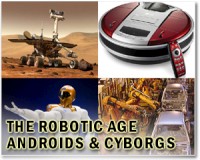 |
Atlanta GA (SPX) Mar 14, 2011 Getting someone's attention can be easy with a loud noise or a shout, but what if the situation calls for a little more tact? How can a robot use subtle cues to attract a human's notice and tell when it has captured it? In a preliminary study, researchers at the Georgia Institute of Technology have found that they can program a robot to understand when it gains a human's attention and when it falls short. The research was presented at the Human-Robot Interaction conference in Lausanne, Switzerland. "The primary focus was trying to give Simon, our robot, the ability to understand when a human being seems to be reacting appropriately, or in some sense is interested now in a response with respect to Simon and to be able to do it using a visual medium, a camera," said Aaron Bobick, professor and chair of the School of Interactive Computing in Georgia Tech's College of Computing. Using the socially expressive robot Simon, from Assistant Professor Andrea Thomaz's Socially Intelligent Machines lab, researchers wanted to see if they could tell when he had successfully attracted the attention of a human who was busily engaged in a task and when he had not. "Simon would make some form of a gesture, or some form of an action when the user was present, and the computer vision task was to try to determine whether or not you had captured the attention of the human being," said Bobick. With close to 80 percent accuracy Simon was able to tell, using only his cameras as a guide, whether someone was paying attention to him or ignoring him. "We would like to bring robots into the human world. That means they have to engage with human beings, and human beings have an expectation of being engaged in a way similar to the way other human beings would engage with them," said Bobick. "Other human beings understand turn-taking. They understand that if I make some indication, they'll turn and face someone when they want to engage with them and they won't when they don't want to engage with them. "In order for these robots to work with us effectively, they have to obey these same kinds of social conventions, which means they have to perceive the same thing humans perceive in determining how to abide by those conventions," he added. Researchers plan to go further with their investigations into how Simon can read communication cues by studying whether he can tell by a person's gaze whether they are paying attention or using elements of language or other actions. "Previously people would have pre-defined notions of what the user should do in a particular context and they would look for those," said Bobick. "That only works when the person behaves exactly as expected. Our approach, which I think is the most novel element, is to use the user's current behavior as the baseline and observe what changes." The research team for this study consisted of Bobick, Thomaz, doctoral student Jinhan Lee and undergraduate student Jeffrey Kiser.
Share This Article With Planet Earth
Related Links Georgia Institute of Technology All about the robots on Earth and beyond!
 Study: Robots can understand humans
Study: Robots can understand humansAtlanta (UPI) Mar 8, 2011 A preliminary study found a robot can be programmed to understand when it gets a human's attention and when it doesn't, U.S. researchers said. The researchers at the Georgia Institute of Technology used a socially expressive robot named Simon to see whether they could determine when the robot successfully attracted the attention of a human who was engaged elsewhere and when he didn't, t ... read more |
|
| The content herein, unless otherwise known to be public domain, are Copyright 1995-2010 - SpaceDaily. AFP and UPI Wire Stories are copyright Agence France-Presse and United Press International. ESA Portal Reports are copyright European Space Agency. All NASA sourced material is public domain. Additional copyrights may apply in whole or part to other bona fide parties. Advertising does not imply endorsement,agreement or approval of any opinions, statements or information provided by SpaceDaily on any Web page published or hosted by SpaceDaily. Privacy Statement |